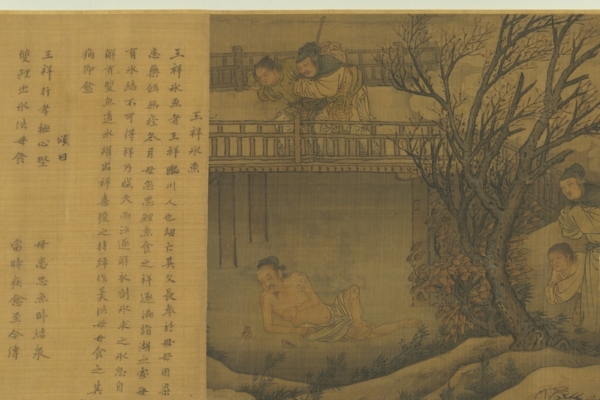The National Palace Museum in Taiwan has launched a special exhibition titled “Paintings that Tell Stories,” which will run until January 1 next year. The exhibition focuses on narrative paintings, aiming to demonstrate the potential and characteristics of images to convey more enriching information beyond textual descriptions.
According to the Taiwan National Palace Museum, images have always possessed a strong communicative power that transcends words, delivering rich and impactful messages. The “Art Speaks: Paintings that Tell Stories” exhibition not only showcases a selection of narrative paintings with diverse storylines but also invites local comic artists to create new illustrations that complement the museum’s collection of ancient paintings, presenting the enduring charm of storytelling through paintings across different eras.
The exhibition is divided into four interconnected units. The first unit, “The Powerful Narrative of Images,” uses various image sources such as stone carvings depicting loyalty and righteousness in ancestral halls, Dunhuang murals depicting Buddha’s life stories, and illustrations accompanying classical philosophical or literary texts like the “Classic of Filial Piety” and the “Book of Songs,” inviting viewers to experience the rich narratives conveyed through images.
The second unit, “Promoting Education and Assisting in Moral Conduct,” embodies the influence of Confucian culture, where paintings serve as important mediums for conveying moral values and inspiring emperors to emulate virtuous behavior, as seen in works like “Twenty-four Filial Exemplars” and “Illustrated Explanations of the Classics.”
The third unit, “Visually Pleasing,” emphasizes the entertainment function of paintings by presenting literary, theatrical, and fictional narratives that evoke emotions such as national identity and familial conflicts, as exemplified in the story of “Lady Wenji’s Return to Han,” allowing viewers to experience the fundamental allure of narrative paintings.
The fourth unit, “Deciphering Stories within Images,” empowers viewers to interpret obscure narrative paintings by piecing together clues and collectively reconstructing the story content, encouraging everyone to become storytellers within the paintings.
Deputy Researcher Qiu Shihua from the Department of Calligraphy and Painting Documents, who curated the exhibition, mentioned that local comic artists were invited to create comic-style visual narratives based on eight selected artworks on display. This approach aims to attract the attention of audiences from the manga generation and highlight key points within the paintings.
Assistant Researcher Lin Wanru from the Department of Calligraphy and Painting Documents highlighted the presence of several national treasures in the exhibition, including the nationally renowned artworks “Lady Wenji’s Return to Han” and “Punishing the Vizier,” which are rarely exhibited for only 42 days. Another set of important ancient artifacts is Li Tang’s “Lady Wenji’s Return to Han” in scroll format, specially displayed at an incline platform for viewers to appreciate its intricate details up close.
In conjunction with the “Art Speaks: Paintings that Tell Stories” exhibition, the fourth season of “Focus on National Treasures” also presents the Song dynasty painting “Qu Zuo Tu.” This artwork draws from historical facts during the reign of Emperor Wen of Han and depicts an incident where the minister Yuan Ang advises the emperor not to let his favored concubine Shunfu take precedence in seating arrangements during a visit to Shanglin Park, to prevent disorder and potential harm. The painting portrays Shunfu’s reluctance to take her seat, Yuan Ang’s counseling, and the attentive gaze of Emperor Wen, accompanied by armed guards. While the characters’ expressions appear calm and solemn at first glance, the subtle tension conveyed through Emperor Wen’s and the guards’ focused expressions adds depth to the narrative, fully showcasing the captivating storytelling power of images for viewers to appreciate in detail.

